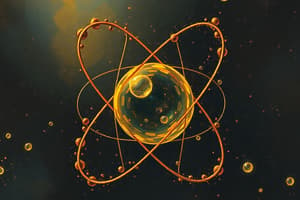Podcast
Questions and Answers
Which of the following statements accurately describes the relationship between the nucleus and electrons in an atom?
Which of the following statements accurately describes the relationship between the nucleus and electrons in an atom?
- The nucleus is positively charged and the electrons are negatively charged. (correct)
- The nucleus and electrons have the same charge.
- The nucleus is negatively charged and the electrons are positively charged.
- The nucleus and electrons are not charged.
Which subatomic particle is responsible for the majority of an atom's mass?
Which subatomic particle is responsible for the majority of an atom's mass?
- Electrons
- Neutrons
- Both protons and neutrons (correct)
- Protons
Which of the following statements accurately reflects the concept of electron shells within an atom?
Which of the following statements accurately reflects the concept of electron shells within an atom?
- Electrons closer to the nucleus have lower energy levels, while electrons in the outermost shell have higher energy levels. (correct)
- Electron shells represent all places electrons could potentially orbit, and do not represent a specific energy level.
- Electron shells represent specific locations where electrons can be found, these locations do not represent different energy levels.
- Electrons closer to the nucleus have higher energy levels, while electrons in the outermost shell have lower energy levels.
What is the approximate size of an atom, compared to the size of its nucleus?
What is the approximate size of an atom, compared to the size of its nucleus?
Which of the following statements correctly describes the relative mass of protons, neutrons, and electrons?
Which of the following statements correctly describes the relative mass of protons, neutrons, and electrons?
Flashcards
Atom
Atom
The smallest unit of matter, made of subatomic particles.
Subatomic Particles
Subatomic Particles
Particles smaller than atoms, including protons, neutrons, and electrons.
Nucleus
Nucleus
The central part of an atom, containing protons and neutrons.
Electrons
Electrons
Signup and view all the flashcards
Electron Shells
Electron Shells
Signup and view all the flashcards
Study Notes
Atom Structure
- Atoms are tiny particles, too small to see with the naked eye and only visible with the most powerful microscopes.
- Everything in the universe is made up of atoms, including humans and devices.
- An average human body is composed of approximately 7 * 10^27 atoms.
Subatomic Particles
- Atoms are composed of even smaller particles called subatomic particles.
- Atoms have a central nucleus containing protons and neutrons.
- Protons carry a positive charge, and neutrons have no charge.
- The nucleus has a positive charge, similar to the sun with orbiting planets.
- Electrons orbit the nucleus and have a negative charge.
- Due to opposite charges, the nucleus and electrons are electrostatically attracted, resembling the gravitational attraction between planets and the sun.
Mass and Size of Atoms
- Protons and neutrons have equal mass.
- Electrons are significantly lighter, around 2000 times lighter than protons and neutrons.
- The majority of an atom's mass is concentrated in the nucleus, which is very small compared to the atom's overall size.
- The radius of an atom, measured from the nucleus to the outermost electron shell, is typically 10^-10 meters, making atoms extremely small.
- If an atom were the size of a sports arena, the nucleus would be about the size of a "p" in the center.
Electron Shells
- Negatively charged electrons orbit the positively charged nucleus in specific orbits called shells or orbitals.
- Different atoms have different numbers of shells.
- Each shell represents a specific energy level.
- Electrons closer to the nucleus have lower energy levels, while electrons in the outermost shell have higher energy levels.
- Electrons orbit the nucleus similar to planets orbiting the sun, but they can only exist at specific distances and energy levels.
Studying That Suits You
Use AI to generate personalized quizzes and flashcards to suit your learning preferences.




